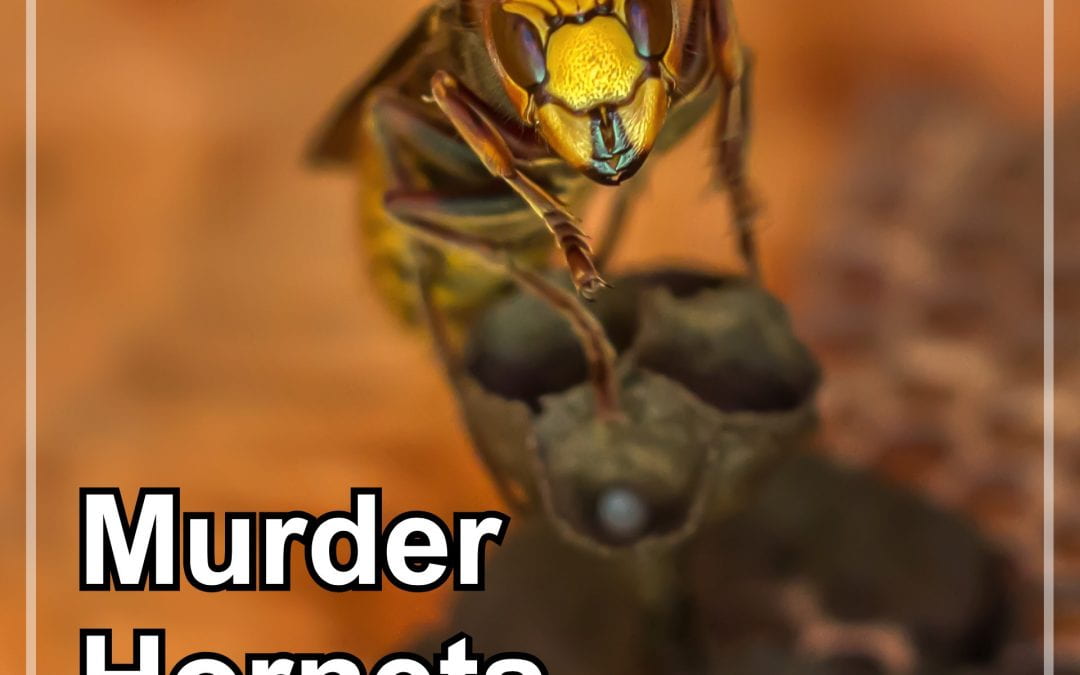Our editing continues but as news like this surfaces, we must “Bee Aware” and bring attention to it. As if we needed more things to worry about in 2020, the United States is now facing a threat that could devastate it’s ecosystem. The threat is an insect named the Asian Giant Hornet, commonly known as the Murder Hornet. The Asian Giant Hornet earned the name “Murder Hornet” because of its aggressive group attacks which can expose victims to enough toxic venom to be fatal. In Japan, it is recorded that 50 people die from these Hornets every year. These hornets are excellent hunters and they are known to kill entire colonies of honey bees.
Before we dive deeper about the Hornets invasion into the United States, we need to talk about these natural hunters. The hornets are native in temperate and tropical parts of Asia and far-eastern Russia. They usually make their homes in forests and low mountain ranges. They typically create their nests underground in pre-existing rodent tunnels or near rotted tree roots. The hornet’s body can grow as long as 1.8 inches with a stinger 0.24 inches long—making them the world’s largest hornet. Aside from being the largest hornet, these killers also have a unique look with large teardrop-shaped eyes, tiger-like orange and black stripes extending down its body, and broad wings similar to a dragonfly. The hornet also sports a tough and rigid exoskeleton that can deflect multiple attacks including the honey bee stingers. One of weapons that the Hornet has is its large spiked mandibles that can easily decapitate its prey. The other weapon is the stinger which can paralyze its prey for the easy kill. They can use the stinger multiple times for lethal effect. Now to a human the sting would not be enough to kill you but multiple stings can be toxic. With multiple stings the venom can cause anaphylactic shock or heart failure. The pain from these stings are excruciating, it has been reported that it feels like a hot iron nail piercing your body.
While the Murder Hornet is common in Japan, they were first spotted in North America just last year. The first appearance occurred on Vancouver Island in British Columbia, Canada in September 2019. A few months later, the US has its first sighting in Washington State near the Canadian border in December 2019. After tests confirmed the two hornets did not belong to the same nest, beekeepers grew more concerned.
In April 2020, there were more sightings in Washington with reports of entire hives being destroyed. One beekeeper reported that all he found left of his hive were the headless bodies of his bees. With local beekeepers worrying that their honeybee population could be wiped out by the hornets; they are busy tracking down and destroying Murder Hornet nests. US authorities are busy trying to figure out how the invasive species made it to North America. Authorities are still unsure how the Hornet made it to the Americas, they have been known to be accidentally transported on international cargo ships.
With the weather beginning to warm up, beekeepers have ramped up their hunt to eliminate the problem before it becomes unmanageable. Towards the end of the summer is when the Murder Hornet becomes most active as they seek out sources of protein to raise their queen for the next season. The Murder Hornets are extrememly dangerous to honeybees and are capable of killing one honeybee every 14 seconds. This means entire honeybee colonies can be wiped out in a matter of hours. Murder Hornets are known to hunt honeybees in particular and specialize in group attacks. When a worker hornet finds a honeybee colony, it marks it with a pheromone, attracting up to 50 other hornets to begin their slaughter. The hornet’s large mandibles decapitate the honeybee and then they bring the dead bee’s thorax back to their nest to feed their larva. (warning, video is graphic)
What makes this Hornet so deadly to honeybees in the United States is that the honeybees have no natural defenses or strategies to fend off these hornets. The most common honeybee in the United States is the European honeybee which has no natural way of defending themselves against the hornet. The only weapon for the honeybee is the stinger which is easily deflected off the tough and rigid exoskeleton of the Hornet. In Japan, the Japanese honeybee, after years of defending their hives from the hornets, found a way to deal with them. When a hornet attacks a nest, hundreds of Japanese honeybees pounce to action and surround the hornet. They form a large ball around the hornet and use vibrations in their bodies to heat themselves up. The hornet will die being cooked alive while the honey bees can survive those temperatures. But the European honeybee has not defended against this type of threat before so they are defenseless to a larger and stronger foe.
Agricultural officials in Washington State are asking everyone to report any sighting of the Murder Hornets. A successful elimination strategy relies on a quick response by the population. To locate Murder Hornet nests, researchers began using thermal imaging to spot underground nests that can reach temperatures up to 86 degrees. They can also use special listening devices that can detect the hornet’s distinctive buzz to locate nests. Some beekeepers have even created traps for the Murder Hornet near their honeybee colonies in an attempt to capture one when it is hunting for food. Researchers can then use radio-frequency ID tags or attach a small streamer to the hornet in order to follow it as it returns to its nest. Once a nest is found, the hornets can be wiped out with carbon dioxide. However, this is not a particularly safe job as the Murder Hornet’s stinger is known to peirce layers of protective gear including a bee suit. Coupled with their propensity to attack in groups and the lethality of their venom, beekeepers, researchers, and the general public should always approach with caution.
Luckily, officials in Washington are taking action to erradicate the Murder Hornet before it is able to call the United States home. By developing a coordinated response with beekeepers, researchers, agricultural authorities, and the public, the response should be swift and comprehensive. With US honeybee populations already on the decline, it is important that we prevent these invasive killers from putting further stress on our bees and beekeepers.
Do you or someone you know keep bees? We want to hear your story! Pace University’s Pace Docs crew is in the process of producing a documentary about Urban Beekeeping, the latest in a series of award-winning environmentally and culturally relevant documentaries from our department. Contact us at paceudocs@gmail.com. And follow us on Instagram, Facebook, Twitter, and Tik Tok for more content!

